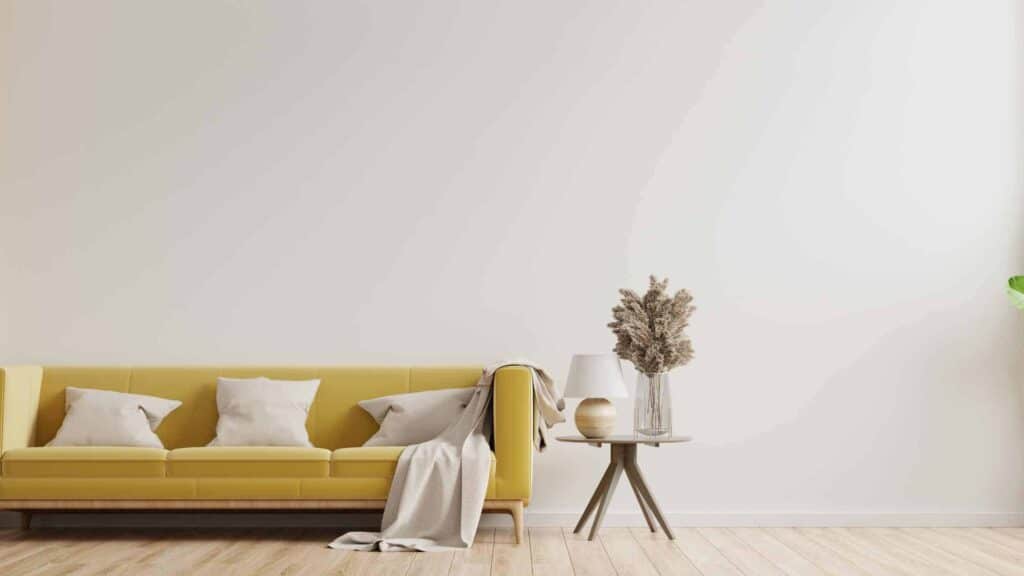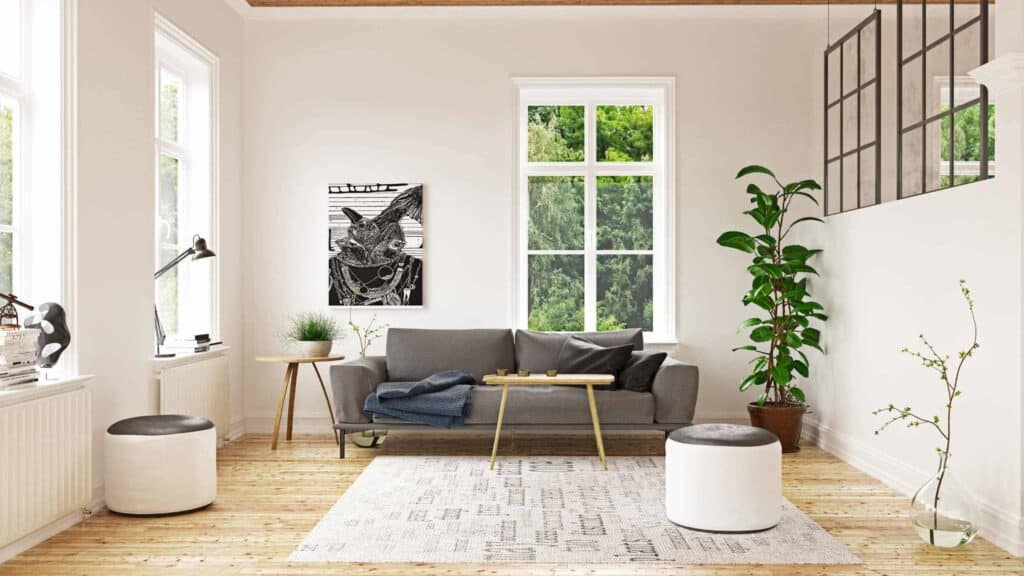Discover the sophistication disguised in Nordic design’s simplicity and functionality. Minimal furniture and a lot of comfort, linear lines with an enveloping appearance, and refinement without pretense. Scandinavian design is appealing because of its simplicity, which exudes elegance.
Scandinavian design has dominated the world with its minimalist approach of neutral colors and straight lines. In this article, we will explore everything you need to know about Scandinavian design, from its origins to the key elements that define it.
Scandinavian design, known internationally as a style that prioritizes simplicity, functionality, and beauty, has become a trend in the worlds of building and décor.
The Scandinavian movement, which originated in Northern Europe, introduced to the market a style that values the natural luminosity of the environment and, above all, minimalism. Its other qualities include neutral colors and furniture with straight lines.
Design from Scandinavian countries extended over the world in the twentieth century, becoming an international reference in terms of ornamentation and architecture. Learn about its history and how and why this concept got so popular among minimalist design enthusiasts.
Lina Bo Bardi, a famous architect who values simplicity to achieve great results, once said, “There is a taste of victory and delight in being simple. It doesn’t take a lot to be a lot.”
What Is Nordic Design Anyway?
Several design types have risen in popularity, from rustic farmhouses to mid-century contemporary to eclectic bohemian, but none seem to have the same staying power as the Scandinavian style. Scandi décor has a certain allure that people can’t get enough of.
And we’re not just talking about IKEA’s continuous success. Scandinavian design features clean lines, minimalism, and a lack of clutter, which can be visually appealing.
Some of the appeals stem from how ambitious this particular design style appears. The natural beauty and brightness generate a sense of tranquility that many people lack in their daily lives. Following a long day at work, the prospect of going home to a home devoid of cumbersome furniture and clutter is especially enticing.

Scandinavian design, also known as Nordic style, has become a worldwide trend and has become a part of the daily lives of many who adore the minimalist style of this movement. Scandinavian design is distinguished by a minimalist, clean aesthetic that attempts to combine efficiency and beauty.
Its emphasis is on clean lines and light rooms free of clutter. These concepts apply to all aspects of design, from architecture to electronics. However, they are most typically applied to interior design, which includes furniture, textiles, ceramics, and lighting. Scandinavian design, in general, is devoid of superfluous aspects; it strips away the useless, highlighting the vital elements of any object.
Scandinavian design, which emerged in the twentieth century, is distinguished by functionality, simplicity, and minimalism. The Nordic design favors a palette of neutral colors, primarily white and shades of gray and beige, as well as natural lighting in the interior.
Light wood is also often employed in this sort of decoration, such as for furniture legs, floors, and other things, giving the area a modern yet timeless feel. Furniture typically has straight lines and simple designs.
We highlight the following as key elements of Scandinavian design:
Neutral hues are genuine protagonists of the Scandinavian environment and are one of the most important elements of this design. Yet, to make the space less frigid, elements with an aged appearance might be incorporated, with the goal of generating a contrast.
Another option to break up the monotony of the surroundings is to employ somewhat brighter colors in certain parts of the space, such as earthy or bluish tones. In addition to white furniture, wood can be used to make the space feel cozier.
Scandinavian hues are mostly neutral and monochromatic – bright, warm whites with black and tan accents – with splashes of color utilized as highlights. Soft pinks, gray-blues, and natural-inspired colors like sage are the most popular in Scandinavian design.
Organic and natural materials frequently take center stage in Scandinavian design, representing the Nordic and Scandinavian countries’ bond with nature. Wood softened to match a neutral color palette, cotton, and wool, as well as houseplants, play an important role in Scandinavian design.
Minimalist Nordic Design
The Nordic design exemplifies the ideas of Mies van der Rohe’s adage “less is more” when it comes to creating a functional and beautiful setting. Elements that produce a clean and comfortable environment are used for this.
The phrase “Scandinavian design” derives from the Scandinavia region, which includes five northern European countries: Finland, Sweden, Iceland, Denmark, and Norway. The present Scandinavian design movement started in the early twentieth century and flourished throughout the five Nordic countries from the 1930s forward.
Because of the harsh cold and ensuing darkness that winter brings, a design that provides clarity and illumination inside the buildings was considered, relying on utilitarian and fundamental features. This design was later dubbed Scandinavian, a reference to the European continent.
Architects and designers from many lines have contributed to the history of Scandinavian design, with the Swedish artist Carl Larsson serving as the style’s primary inspiration. The designer illustrated his home’s rooms, usually utilizing neutral colors, simple furnishings, and straight lines.
Another prominent name in Scandinavian design is the Danish designer Hans Wegner. He became known around the world for incorporating organic practicality into modernism and promoting the development of high-quality products in Denmark.
A guiding principle of Scandinavian design is to produce products that are durable and in tune with their surroundings. It aims to promote the art of living well by fostering a basic home setting filled with excellent products and enhancing an unconstrained existence free of unnecessary consumerism.
In this regard, it is vital for both individuals and the earth, as a home environment that supports a life well lived is an increasingly important counter to the rigors of modern living.

The Scandinavian-style decor has taken over homes all around the world, including in Brazil. This design has become a feverish obsession in this country, with many followers of minimalism in design and architecture.
As previously said, the Scandinavian interior design emphasizes neutral colors, straight lines, and a clean environment. Yet, contrasting tones that do not stray from those already present in the area and diverse elements, such as wood, ceramics, glass, and even acrylic, can be used.
The objective is to focus on creating efficient and practical spaces with modern and high-quality objects, always prioritizing comfort combined with elegance and originality in how the parts are assembled and connected to one another.
Scandinavian design is minimalist, so the few objects in the space have to make a statement, which is why the humble chair is given so much attention. Any object in Scandinavian decor is likely to exhibit craftsmanship and timeless design.
Because the Nordic nations get so little natural light throughout the winter, lighting is an important aspect of Scandinavian architecture. Lamps and lighting solutions, in addition to optimizing natural light wherever possible with white walls or large windows, are crucial.
There should be numerous light sources in every space, ranging from the warm, gentle glow of a candle to the dazzling overhead glare of a ceiling light. The Scandinavian design strives to diffuse light as evenly as possible without producing a harsh environment. Poul Henningsen’s eye-catching light designs are a prime example.
The designer sought a way to disperse the light from the bulb as broadly as possible while minimizing glare. This resulted in his lamp’s lovely floral shape, with each petal shape softening and dispersing the bulb’s light.
With Swedish design’s practical bent, it’s no wonder that sustainability is now an inherent part of much current Scandinavian design. Nordic design ideals of craftsmanship, quality, and making life easier are excellent bedfellows for sustainability. This naturally aims to return to slow, local manufacturing of high-quality, long-lasting products.
Scandinavian design can be expensive, but there are several reasons behind this. Durability, material quality, timeless design (as in, not trendy and thus will look wonderful in your home for a long time), and professional craftsmanship are some of the factors that contribute to the price.
Don’t be tricked into spending more just because something says “hygge” on it. Buying high-quality components will cost more upfront but less in the long run because you won’t need to replace them.
If you have the means to spend a little money, or even save up over time, the best advice is to select which big-ticket items are worth spending money on. This includes items such as a bed, couch, and lighting, and making decisions accordingly.
Scandinavian design has proven to have a timeless aesthetic, inspiring many designers and homeowners. Because of its efficiency, simplicity, and beauty, it is a popular choice for individuals looking for a minimalist and beautiful style.
Understanding the history and characteristics of the style will help you create a space that is both beautiful and functional. This is the case whether you are trying to add some Scandinavian design aspects to your home or looking to build a complete Scandinavian-inspired room.
